HBIM Modeling from the Surface Mesh and Its Extended Capability of Knowledge Representation
Abstract
:1. Introduction
2. State of the Art
2.1. Scan-to-HBIM and Mesh-to-HBIM
2.2. HBIM and Ontology
3. Methodology
3.1. Study Area
3.2. HBIM Environment for Semantic Modeling and Knowledge Management
3.3. Conventional Scan-to-HBIM
3.4. Mesh-to-HBIM
3.5. HBIM with an Extended Capability of Knowledge Representation
4. Results and Discussion
4.1. Parametric/Semantic HBIM Models
4.2. HBIM and Ontology: Geometry and Semantics
5. Conclusions
Author Contributions
Funding
Conflicts of Interest
References
- Grussenmeyer, P.; Landes, T.; Voegtle, T.; Ringle, K. Comparison methods of terrestrial laser scanning, photogrammetry and tachometry data for recording of cultural heritage buildings. Int. Arch. Photogramm. Remote Sens. Spat. Inf. Sci. 2008, XXXVI, 213–218. [Google Scholar]
- Rüther, H.; Chazan, M.; Schroeder, R.; Neeser, R.; Held, C.; Walker, S.J.; Matmon, A.; Horwitz, L.K. Laser scanning for conservation and research of African cultural heritage sites: The case study of Wonderwerk Cave, South Africa. J. Archaeol. Sci. 2009, 36, 1847–1856. [Google Scholar] [CrossRef]
- Remondino, F. Heritage recording and 3D modeling with photogrammetry and 3D scanning. Remote Sens. 2011, 3, 1104–1138. [Google Scholar] [CrossRef]
- Aicardi, I.; Chiabrando, F.; Maria Lingua, A.; Noardo, F. Recent trends in cultural heritage 3D survey: The photogrammetric computer vision approach. J. Cult. Herit. 2018, 32, 257–266. [Google Scholar] [CrossRef]
- De Luca, L. Methods, formalisms and tools for the semantic-based surveying and representation of architectural heritage. Appl. Geomatics 2011, 6, 115–139. [Google Scholar] [CrossRef]
- Remondino, F.; Lo Buglio, D.; Nony, N.; De Luca, L. Detailed Primitive-Based 3D Modeling of Architectural Elements. ISPRS - Int. Arch. Photogramm. Remote Sens. Spat. Inf. Sci. 2012, XXXIX-B5, 285–290. [Google Scholar] [CrossRef]
- Xiong, X.; Adan, A.; Akinci, B.; Huber, D. Automatic creation of semantically rich 3D building models from laser scanner data. Autom. Constr. 2013, 31, 325–337. [Google Scholar] [CrossRef] [Green Version]
- Quattrini, R.; Pierdicca, R.; Morbidoni, C. Knowledge-based data enrichment for HBIM: Exploring high-quality models using the semantic-web. J. Cult. Herit. 2017. [Google Scholar] [CrossRef]
- Tang, P.; Huber, D.; Akinci, B.; Lipman, R.; Lytle, A. Automatic reconstruction of as-built building information models from laser-scanned point clouds: A review of related techniques. Autom. Constr. 2010, 19, 829–843. [Google Scholar] [CrossRef]
- Adán, A.; Quintana, B.; Prieto, S.A.; Bosché, F. Scan-to-BIM for ‘secondary’ building components. Adv. Eng. Informatics 2018, 37, 119–138. [Google Scholar] [CrossRef]
- Fai, S.; Filippi, M.; Paliaga, S. Parametric modelling (BIM) for the documentation of vernacular construction methods: A BIM model for the commissariat building, Ottawa, Canada. ISPRS Ann. Photogramm. Remote Sens. Spat. Inf. Sci. 2013, II, 115–120. [Google Scholar] [CrossRef]
- Murphy, M.; McGovern, E.; Pavia, S. Historic Building Information Modelling–Adding intelligence to laser and image based surveys of European classical architecture. ISPRS J. Photogramm. Remote Sens. 2013, 76, 89–102. [Google Scholar] [CrossRef]
- Bianchini, C.; Nicastro, S. The definition of the level of reliability: A contribution to the transparency of historical-bim processes. Dn. Build. Inf. Model. Data Semant. 2018, 2, 46–60. [Google Scholar]
- Murphy, M.; McGovern, E.; Pavia, S. Historic building information modelling (HBIM). Struct. Surv. 2009, 27, 311–327. [Google Scholar] [CrossRef] [Green Version]
- Bianchini, C.; Inglese, C.; Ippolito, A. The role of BIM (Building Information Modeling) for representation and managing of built and historic artifacts. Disegnarecon 2016, 9, 10–11. [Google Scholar]
- Yang, X.; Koehl, M.; Grussenmeyer, P.; Macher, H. Complementarity of historic building information modelling and geographic information systems. In Proceedings of the International Archives of the Photogrammetry, Remote Sensing and Spatial Information Sciences, Prague, Czech Republic, 15 June 2016; Volume XLI, pp. 437–443. [Google Scholar] [CrossRef]
- Murphy, M.; Corns, A.; Cahill, J.; Eliashvili, K.; Chenau, A.; Pybus, C.; Shaw, R.; Devlin, G.; Deevy, A.; Truong-Hong, L. Developing historic building information modelling guidelines and procedures for architectural heritage in Ireland. Int. Arch. Photogramm. Remote Sens. Spat. Inf. Sci. 2017, XLII–2, 539–546. [Google Scholar] [CrossRef]
- López, F.J.; Lerones, P.M.; Llamas, J.; Gómez-García-Bermejo, J.; Zalama, E. A Framework for Using Point Cloud Data of Heritage Buildings Toward Geometry Modeling in A BIM Context: A Case Study on Santa Maria La Real De Mave Church. Int. J. Archit. Herit. 2017, 11, 965–986. [Google Scholar] [CrossRef]
- Barazzetti, L.; Banfi, F.; Brumana, R.; Previtali, M. Creation of Parametric BIM Objects from Point Clouds Using Nurbs. Photogramm. Rec. 2015, 30, 339–362. [Google Scholar] [CrossRef]
- Barazzetti, L.; Banfi, F.; Brumana, R.; Gusmeroli, G.; Previtali, M.; Schiantarelli, G. Cloud-to-BIM-to-FEM: Structural simulation with accurate historic BIM from laser scans. Simul. Model. Pract. Theory 2015, 57, 71–87. [Google Scholar] [CrossRef]
- Barazzetti, L. Parametric as-built model generation of complex shapes from point clouds. Adv. Eng. Informatics 2016, 30, 298–311. [Google Scholar] [CrossRef]
- Garagnani, S.; Manferdini, A.M. Parametric accuracy: Building information modeling process applied to the cultural heritage preservation. ISPRS - Int. Arch. Photogramm. Remote Sens. Spat. Inf. Sci. 2013, XL–5, 87–92. [Google Scholar] [CrossRef]
- Garagnani, S. Building Information Modeling and real world knowledge: A methodological approach to accurate semantic documentation for the built environment. In Proceedings of the Digital Heritage International Congress (DigitalHeritage), Marseille, France, 28 October–1 November 2013; pp. 489–496. [Google Scholar] [CrossRef]
- Pauwels, P.; Di Mascio, D. Interpreting Metadata and Ontologies of Virtual Heritage Artefacts. Int. J. Herit. Digit. Era 2014, 3, 531–555. [Google Scholar] [CrossRef]
- Pauwels, P.; Krijnen, T.; Terkaj, W.; Beetz, J. Enhancing the ifcOWL ontology with an alternative representation for geometric data. Autom. Constr. 2017, 80, 77–94. [Google Scholar] [CrossRef] [Green Version]
- Simeone, D.; Cursi, S.; Toldo, I.; Carrara, G. B ( H ) IM - Built Heritage Information Modelling. Extending BIM approach to historical and archaeological heritage representation. eCAADe 2009, 1, 613–622. [Google Scholar]
- Acierno, M.; Cursi, S.; Simeone, D.; Fiorani, D. Architectural heritage knowledge modelling: An ontology-based framework for conservation process. J. Cult. Herit. 2017, 24, 124–133. [Google Scholar] [CrossRef]
- Simeone, D.; Cursi, S.; Acierno, M. BIM semantic-enrichment for built heritage representation. Autom. Constr. 2019, 97, 122–137. [Google Scholar] [CrossRef]
- Fai, S.; Rafeiro, J. Establishing an Appropriate Level of Detail (LoD) for a Building Information Model (BIM)–West Block, Parliament Hill, Ottawa, Canada. ISPRS Ann. Photogramm. Remote Sens. Spat. Inf. Sci. 2014, II–5, 123–130. [Google Scholar] [CrossRef]
- Santagati, C.; Lo Turco, M. From structure from motion to historical building information modeling: Populating a semantic-aware library of architectural elements. J. Electron. Imaging 2016, 26, 011007. [Google Scholar] [CrossRef]
- Palestini, C.; Basso, A.; Graziani, L. Integrated photogrammetric survey and bim modelling for the protection of school heritage, applications on a case study. Int. Arch. Photogramm. Remote Sens. Spat. Inf. Sci. 2018, 42, 821–828. [Google Scholar] [CrossRef]
- Brilakis, I.; Lourakis, M.; Sacks, R.; Savarese, S.; Christodoulou, S.; Teizer, J.; Makhmalbaf, A. Toward automated generation of parametric BIMs based on hybrid video and laser scanning data. Adv. Eng. Informatics 2010, 24, 456–465. [Google Scholar] [CrossRef]
- Macher, H.; Landes, T.; Grussenmeyer, P. From Point Clouds to Building Information Models: 3D Semi-Automatic Reconstruction of Indoors of Existing Buildings. Appl. Sci. 2017, 7, 1030. [Google Scholar] [CrossRef]
- Thomson, C.; Boehm, J. Automatic geometry generation from point clouds for BIM. Remote Sens. 2015, 7, 11753–11775. [Google Scholar] [CrossRef]
- Antón, D.; Medjdoub, B.; Shrahily, R.; Moyano, J. Accuracy evaluation of the semi-automatic 3D modeling for historical building information models. Int. J. Archit. Herit. 2018, 12, 790–805. [Google Scholar] [CrossRef] [Green Version]
- Bolognesi, C.; Garagnani, S. From a point cloud survey to a mass 3D modelling: Renaissance HBIM in Poggio a Caiano. Int. Arch. Photogramm. Remote Sens. Spat. Inf. Sci. - ISPRS Arch. 2018, 42, 117–123. [Google Scholar] [CrossRef]
- Fryskowska, A.; Stachelek, J. A no-reference method of geometric content quality analysis of 3D models generated from laser scanning point clouds for hBIM. J. Cult. Herit. 2018. [Google Scholar] [CrossRef]
- Rodríguez-Moreno, C.; Reinoso-Gordo, J.F.; Rivas-Lpez, E.; Gmez-Blanco, A.; Ariza-Lpez, F.J.; Ariza-Lpez, I. From point cloud to BIM: An integrated workflow for documentation, research and modelling of architectural heritage. Surv. Rev. 2016, 50, 212–231. [Google Scholar] [CrossRef]
- Yang, X.; Koehl, M.; Grussenmeyer, P. Parametric modelling of as-built beam framed structure in bim environment. Int. Arch. Photogramm. Remote Sens. Spat. Inf. Sci. - ISPRS Arch. 2017, 42, 651–657. [Google Scholar] [CrossRef]
- Sun, Z.; Zhang, Y. Using drones and 3D modeling to survey Tibetan architectural heritage: A case study with the multi-door stupa. Sustainability 2018, 10, 2259. [Google Scholar] [CrossRef]
- Castagnetti, C.; Dubbini, M.; Ricci, P.C.; Rivola, R.; Giannini, M.; Capra, A. Critical issues and key points from the survey to the creation of the historical building information model: The case of santo stefano basilica. Int. Arch. Photogramm. Remote Sens. Spat. Inf. Sci. - ISPRS Arch. 2017, 42, 467–474. [Google Scholar] [CrossRef]
- Yang, X.; Koehl, M.; Grussenmeyer, P. Mesh-to-bim: From segmented mesh elements to bim model with limited parameters. Int. Arch. Photogramm. Remote Sens. Spat. Inf. Sci. - ISPRS Arch. 2018, 42, 1213–1218. [Google Scholar] [CrossRef]
- Santagati, C.; Lo Turco, M.; Garozzo, R. Reverse information modeling for historic artefacts: Towards the definition of a level of accuracy for ruined heritage. Int. Arch. Photogramm. Remote Sens. Spat. Inf. Sci. - ISPRS Arch. 2018, 42, 1007–1014. [Google Scholar] [CrossRef]
- Bruno, N.; Roncella, R. A restoration oriented HBIM system for cultural heritage documentation: The case study of parma cathedral. Int. Arch. Photogramm. Remote Sens. Spat. Inf. Sci. - ISPRS Arch. 2018, 42, 171–178. [Google Scholar] [CrossRef]
- Simeone, D.; Cursi, S.; Toldo, I.; Carrara, G. Bim and Knowledge Management for Building Heritage. Acadia 2014, 2014, 681–690. [Google Scholar]
- Messaoudi, T.; Véron, P.; Halin, G.; De Luca, L. An ontological model for the reality-based 3D annotation of heritage building conservation state. J. Cult. Herit. 2018, 29, 100–112. [Google Scholar] [CrossRef] [Green Version]
- Noardo, F. Architectural heritage semantic 3D documentation in multi-scale standard maps. J. Cult. Herit. 2018, 32, 156–165. [Google Scholar] [CrossRef]
- Jung, Y.; Joo, M. Building information modelling (BIM) framework for practical implementation. Autom. Constr. 2011, 20, 126–133. [Google Scholar] [CrossRef]
- Abanda, F.H.; Kamsu-Foguem, B.; Tah, J.H.M. BIM–New rules of measurement ontology for construction cost estimation. Eng. Sci. Technol. Int. J. 2017, 20, 443–459. [Google Scholar] [CrossRef]
- Ali, M.; Mohamed, Y. A method for clustering unlabeled BIM objects using entropy and TF-IDF with RDF encoding. Adv. Eng. Informatics 2017, 33, 154–163. [Google Scholar] [CrossRef]
- Zhang, L.; Issa, R.R.A. Ontology-based partial building information model extraction. J. Comput. Civ. Eng. 2012, 27, 576–584. [Google Scholar] [CrossRef]
- Simeone, D.; Cursi, S. A platform for enriching BIM representation through semantic web technologies. In Proceedings of the Joint Conference on Computing in Construction, Heraklion, Greece, 4–7 July 2017; pp. 423–430. [Google Scholar] [CrossRef]
- López, F.J.; Lerones, P.M.; Llamas, J.; Gómez-García-Bermejo, J.; Zalama, E. A Review of Heritage Building Information Modeling ( H-BIM ). Multimed. Tools Appl. 2018, 2, 21. [Google Scholar] [CrossRef]
- Oreni, D.; Brumana, R.; Della Torre, S.; Banfi, F.; Barazzetti, L.; Previtali, M. Survey turned into HBIM: The restoration and the work involved concerning the Basilica di Collemaggio after the earthquake (L’Aquila). ISPRS Ann. Photogramm. Remote Sens. Spat. Inf. Sci. 2014, II–5, 267–273. [Google Scholar] [CrossRef]
- Quattrini, R.; Battini, C.; Mammoli, R. Hbim to Vr. Semantic awareness and data enrichment interoperability for parametric libraries of historical architecture. Int. Arch. Photogramm. Remote Sens. Spat. Inf. Sci. - ISPRS Arch. 2018, 42, 937–943. [Google Scholar] [CrossRef]
- Pocobelli, D.P.; Boehm, J.; Bryan, P.; Still, J.; England, H. Building Information Models for Monitoring and Simulation Data. ISPRS TC II Mid-term Symp. “Towards Photogramm. 2020” 2018, XLII, 4–7. [Google Scholar] [CrossRef]
- Lu, Y.C.; Shih, T.Y.; Yen, Y.N. Research on historic BIM of built heritage in Taiwan - A case study of Huangxi Academy. Int. Arch. Photogramm. Remote Sens. Spat. Inf. Sci. - ISPRS Arch. 2018, 42, 615–622. [Google Scholar] [CrossRef]
- Chang, K.-M.; Dzeng, R.-J.; Wu, Y.-J. An Automated IoT Visualization BIM Platform for Decision Support in Facilities Management. Appl. Sci. 2018, 8, 1086. [Google Scholar] [CrossRef]
- Murtiyoso, A.; Grussenmeyer, P. Documentation of heritage buildings using close-range UAV images: Dense matching issues, comparison and case studies. Photogramm. Rec. 2017, 32, 206–229. [Google Scholar] [CrossRef]
- Murtiyoso, A.; Grussenmeyer, P.; Freville, T. Close range uav accurate recording and modeling of St-Pierre-Le-Jeune Neo-Romanesque church in Strasbourg (France). Int. Arch. Photogramm. Remote Sens. Spat. Inf. Sci. 2017, XLII–2, 519–526. [Google Scholar] [CrossRef]
- Pauwels, P.; Terkaj, W. EXPRESS to OWL for construction industry: Towards a recommendable and usable ifcOWL ontology. Autom. Constr. 2016, 63, 100–133. [Google Scholar] [CrossRef]
- Lin, C.J. The STG pattern–application of a “Semantic-Topological-Geometric” information conversion pattern to knowledge-based modeling in architectural conceptual design. Comput. Aided. Des. Appl. 2017, 14, 313–323. [Google Scholar] [CrossRef]
- Quattrini, R.; Pierdicca, R.; Morbidoni, C.; Malinverni, E.S. Conservation-oriented HBIM. The bimexplorer web tool. Int. Arch. Photogramm. Remote Sens. Spat. Inf. Sci. 2017, 42, 275–281. [Google Scholar] [CrossRef]
- Biljecki, F.; Ledoux, H.; Stoter, J. An improved LOD specification for 3D building models. Comput. Environ. Urban Syst. 2016, 59, 25–37. [Google Scholar] [CrossRef] [Green Version]




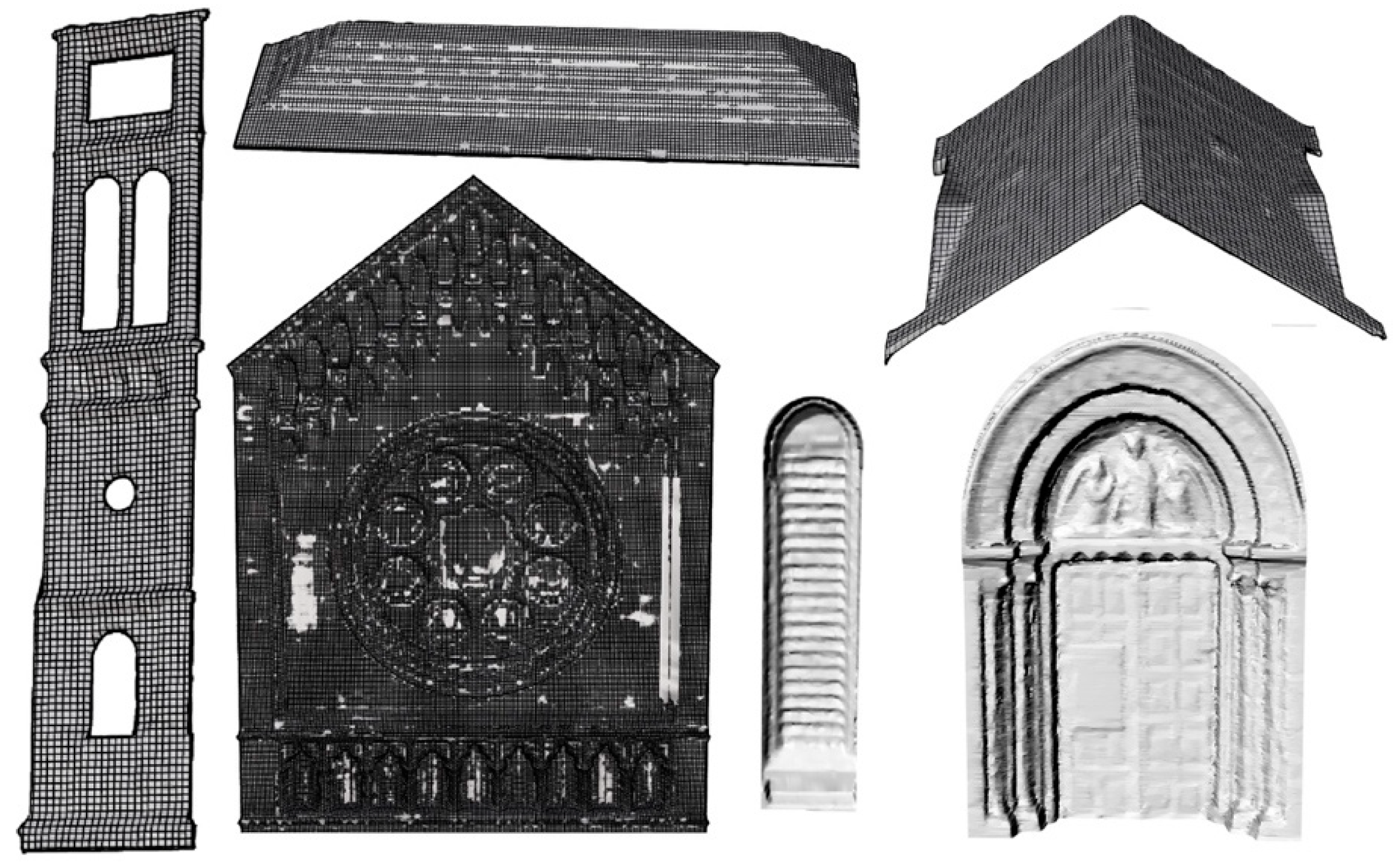
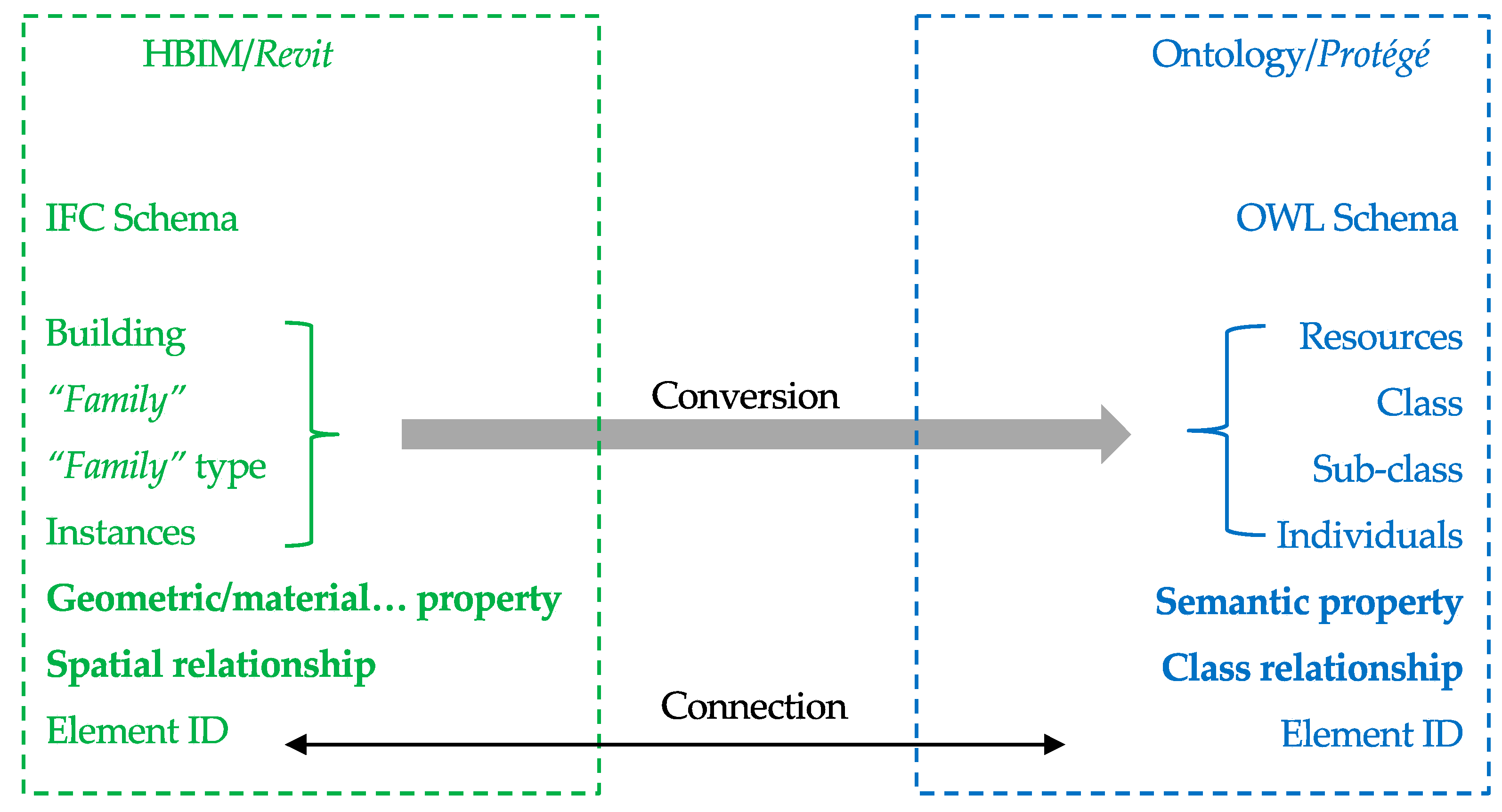

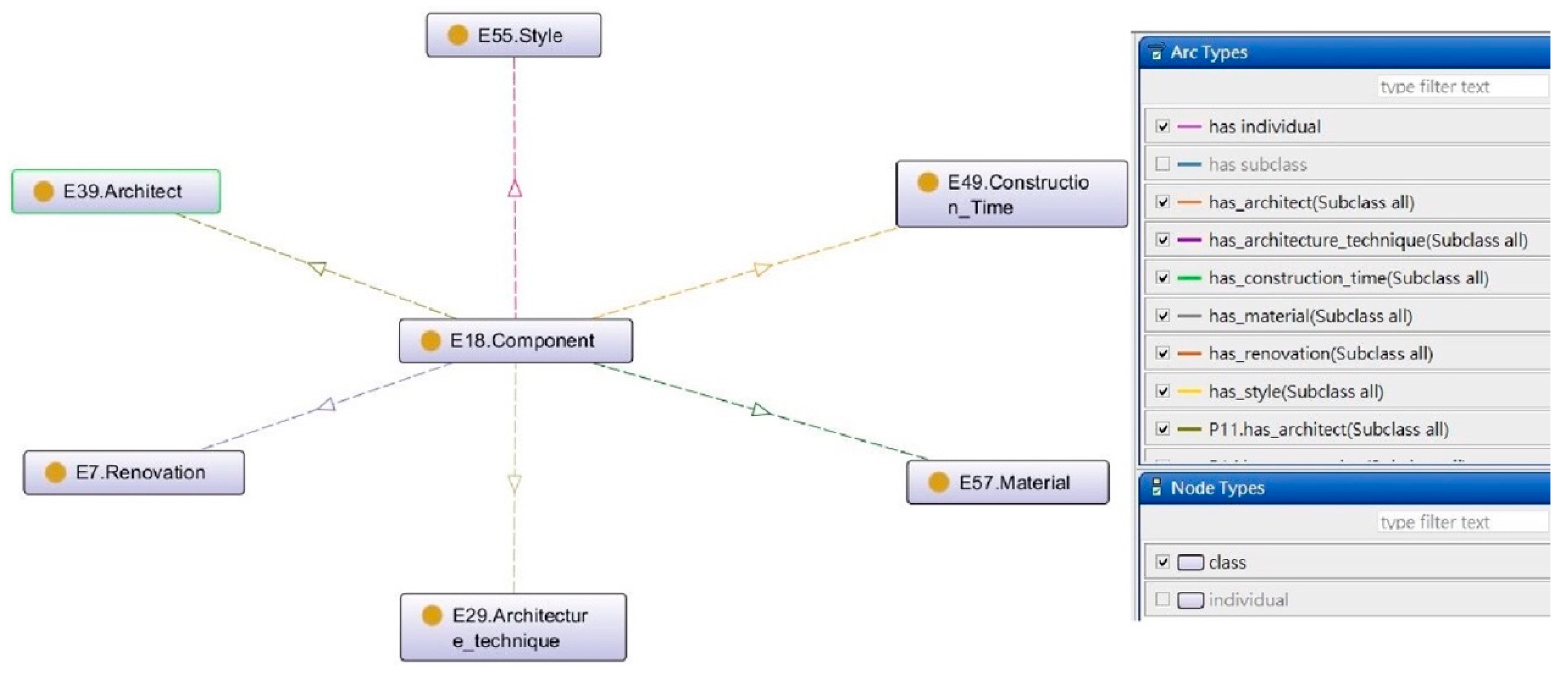

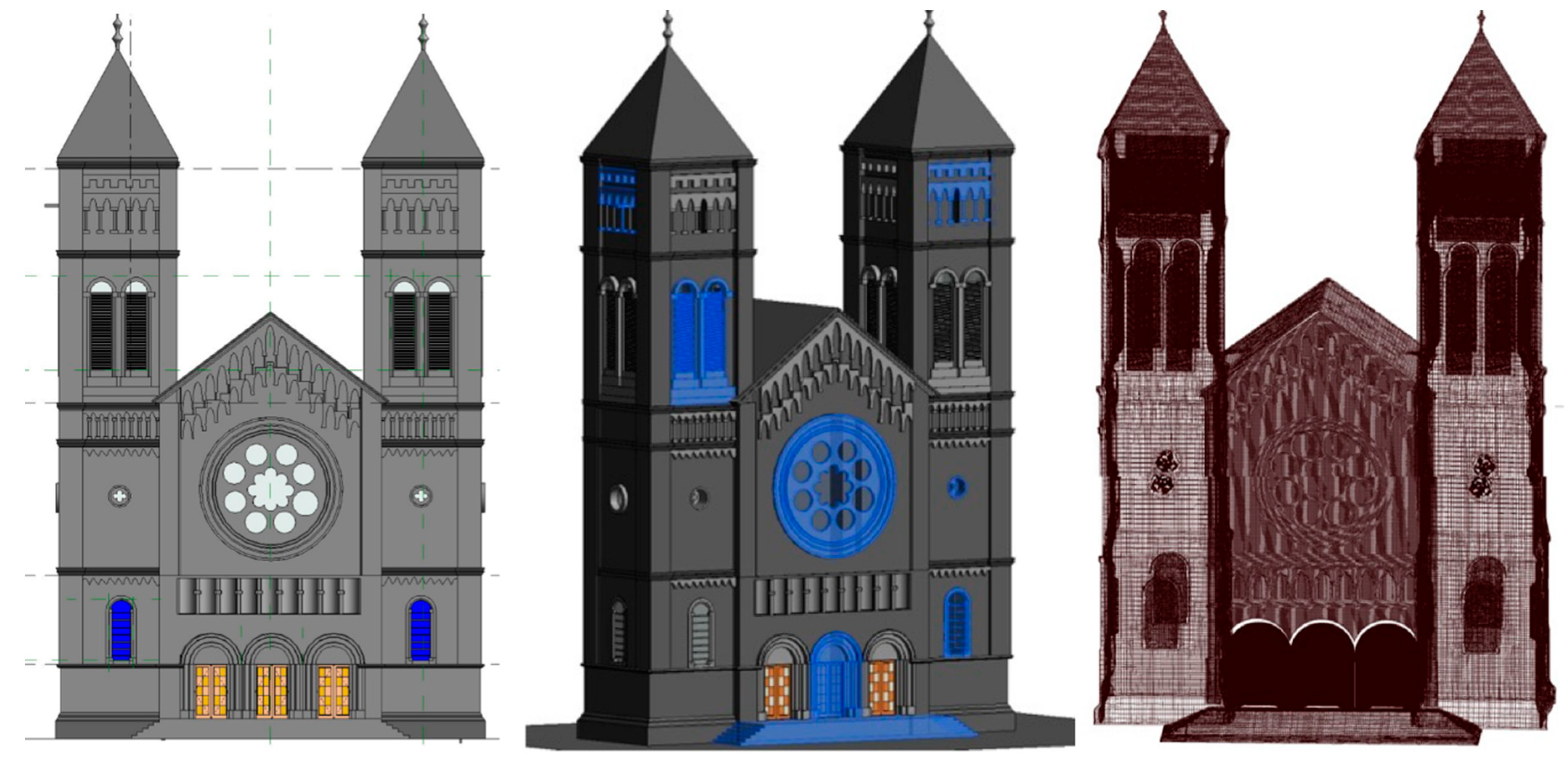
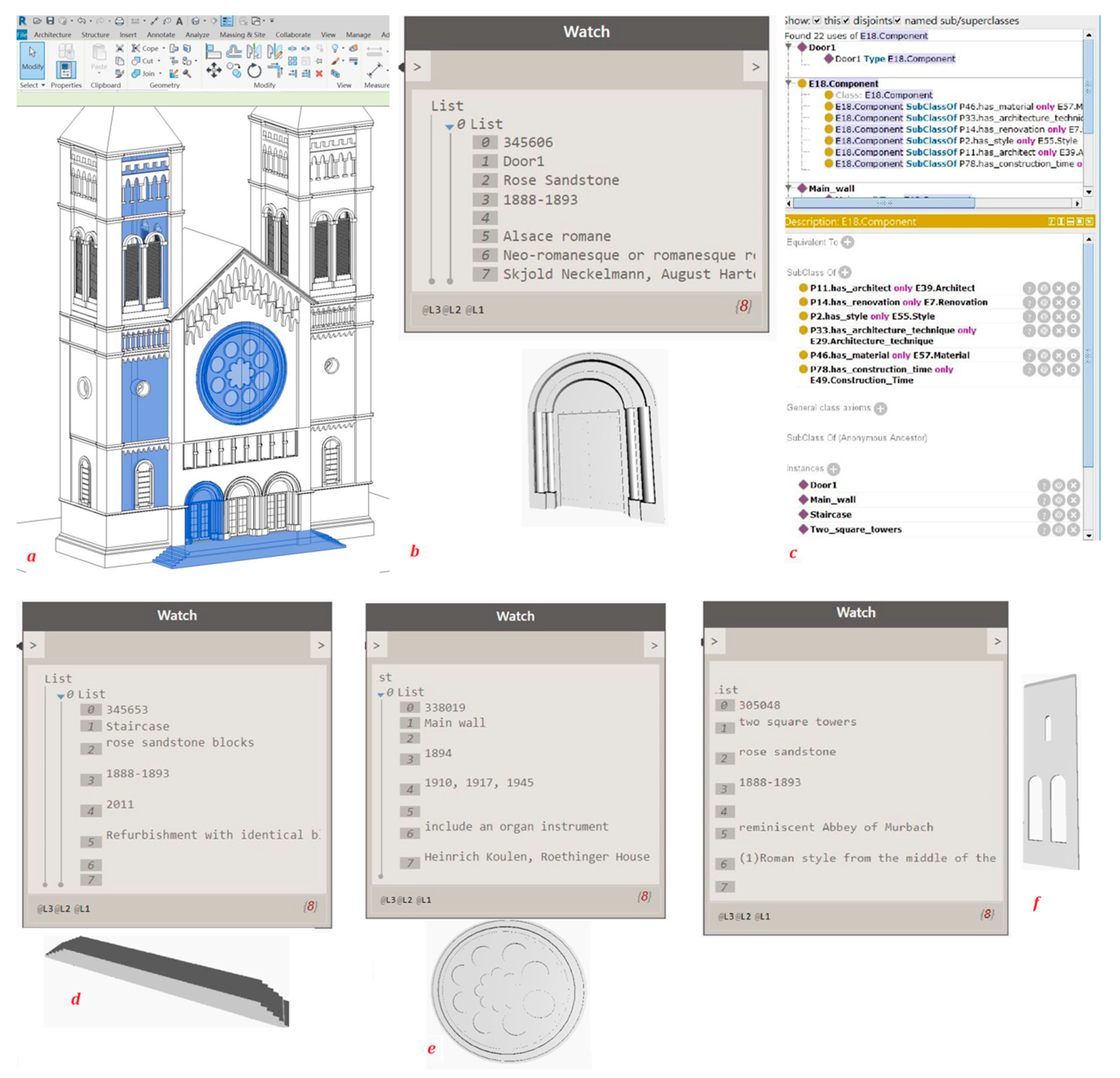
| Aspects | Mesh | Scan-to-HBIM | Mesh-to-HBIM |
|---|---|---|---|
| Manual work | low | high | middle |
| Time complexity depending on | Accuracy | Professional training | Computer performance |
| Geometry | Surface | Volume | Volume |
| Parameter | Non-parametric | Parametric | Non-parametric |
| Semantic | Global and holistic | Local | Local |
| Description | Non-attributes | Attributes | Attributes |
| Relationship | No | Strict | Minimal |
| LOD depending on | Point cloud | Manual drawing | Mesh structure |
| Main limitation | Holistic surface | Time-consuming | Huge size of the file |
© 2019 by the authors. Licensee MDPI, Basel, Switzerland. This article is an open access article distributed under the terms and conditions of the Creative Commons Attribution (CC BY) license (http://creativecommons.org/licenses/by/4.0/).
Share and Cite
Yang, X.; Lu, Y.-C.; Murtiyoso, A.; Koehl, M.; Grussenmeyer, P. HBIM Modeling from the Surface Mesh and Its Extended Capability of Knowledge Representation. ISPRS Int. J. Geo-Inf. 2019, 8, 301. https://0-doi-org.brum.beds.ac.uk/10.3390/ijgi8070301
Yang X, Lu Y-C, Murtiyoso A, Koehl M, Grussenmeyer P. HBIM Modeling from the Surface Mesh and Its Extended Capability of Knowledge Representation. ISPRS International Journal of Geo-Information. 2019; 8(7):301. https://0-doi-org.brum.beds.ac.uk/10.3390/ijgi8070301
Chicago/Turabian StyleYang, Xiucheng, Yi-Chou Lu, Arnadi Murtiyoso, Mathieu Koehl, and Pierre Grussenmeyer. 2019. "HBIM Modeling from the Surface Mesh and Its Extended Capability of Knowledge Representation" ISPRS International Journal of Geo-Information 8, no. 7: 301. https://0-doi-org.brum.beds.ac.uk/10.3390/ijgi8070301





